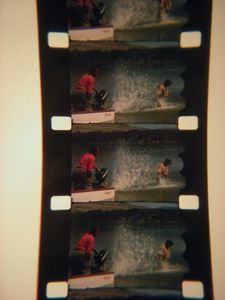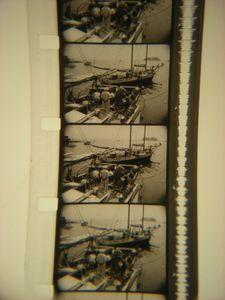| Welcome to Sprocket School! This project is maintained by volunteer editors. Learn more about how this works. |
16mm: Difference between revisions
No edit summary |
No edit summary |
||
| Line 20: | Line 20: | ||
</gallery> | </gallery> | ||
==Sound Formats== | ==Sound Formats== | ||
[[File:Mauer track.JPG|left|thumb|200px|An example of a ''Mauer track''.]] | [[File:Mauer track.JPG|left|thumb|200px|An example of a ''Mauer track''.]] | ||
<div style="clear: both"></div> | <div style="clear: both"></div> | ||
Revision as of 18:03, 19 September 2016

- aspect ratios
- single perf or double perf
- emulsion in or out
- sound formats
16mm Aspect Ratios
The 16mm frame has a native full-frame aspect ratio of ~1.34:1. This is the aspect ratio of the vast majority of 16mm prints.
Other 16mm aspect ratios exist, however. Some prints are hard-matted to widescreen aspect ratios like 1.85 and 1.66 (this is seen with some frequency on 16mm reductions of widescreen feature films originally released on 35mm).
Anamorphic 16mm prints also exist. These have an aspect ratio of 2.66:1 (because of the native 1.33 aspect ratio of the frame). Note that this means that anamorphic 16mm reductions of films originally released as 35mm anamorphic will be cropped slightly at the top and bottom of the frame!
16mm was historically used for the distribution of Hollywood releases to nontheatrical venues (schools, prisons, summer camps, etc.) as well as for television broadcast. Further variations related to aspect ratio crop up on prints that were used for these purposes. These include simple cropping of widescreen or CinemaScope images to 16mm's native 1.33 as well as "pan and scan" efforts.
-
Conventional full frame 16mm print without soundtrack
-
Conventional full frame 16mm print with soundtrack
-
Anamorphic 16mm print
Sound Formats



